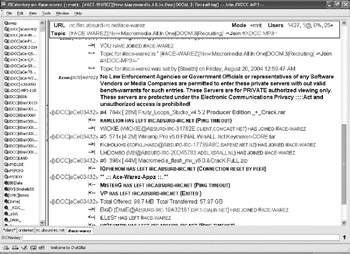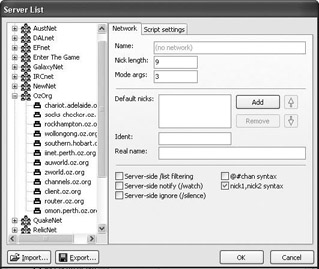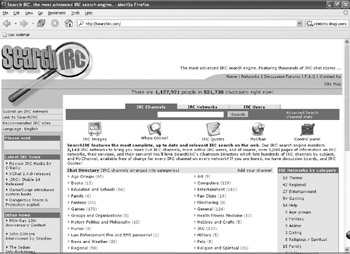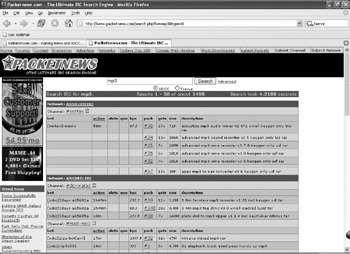INTERNET RELAY CHAT (IRC)
|
| < Day Day Up > |
|
Although the idea of chatting with your friends online might seem like a recent invention, it’s actually been around since the early days of the Internet. The early real-time chatting system, called Internet Relay Chat (or IRC), is often overlooked by many people because it isn’t quite as straightforward or as easy to use as newer, more user-friendly instant messaging services, such as AOL Instant Messenger (AIM) or Yahoo! Messenger.
Hackers typically choose IRC channels over products like AIM or Yahoo! Messenger because IRC channels are unregulated and generally unmoderated. Think Wild Wild West; and they can be wild.
GETTING AN IRC CLIENT
To chat over IRC, you first need to run an IRC client program on your computer (such as the one shown in Figure 4-1), which you use to contact an IRC server.

Figure 4-1: An IRC chat room shows you the nicknames of all the people in the room, along with the messages they’ve already typed.
These are some popular IRC clients for different operating systems:
Windows IRC client programs
mIRC http://www.mirc.co.uk
Pirch http://www.pirch.com
Visual IRC http://www.visualirc.net
Macintosh IRC client programs
Ircle http://www.ircle.com
Snak http://www.snak.com
Linux IRC client programs
BitchX http://www.bitchx.org
XChat http://www.xchat.org
CONNECTING TO AN IRC NETWORK
Once you have an IRC client program on your computer, the next step is to connect to an IRC network. Three of the most popular IRC networks used for file trading include Undernet (http://www.undernet.org), Rizon (http://www.rizon. net), and EFnet (http://www.efnet.org). An IRC network is nothing more than a collection of computers, called servers, which manage all the messages that people type to each other.
Initially, there was just a single computer that formed the first IRC network, so if you wanted to chat with anyone over IRC, you had to connect to this one IRC server to connect to the IRC network.
Naturally, a single computer couldn’t handle all the messages that people all over the world wanted to type, so people started adding additional servers to the IRC network. So instead of connecting to a single IRC server, you could connect to the IRC server closest to you. Whichever server you connected to would relay messages to all the other servers in the IRC network, creating the illusion that everyone was still chatting on the same computer.
Over the years, people running different IRC servers have formed their own IRC networks. As a result, there are now hundreds of different IRC networks, and each is isolated from the other. So if you connect to the DALnet IRC network, you can’t chat with someone connected to the EFnet IRC network, and vice versa.
IRC networks tend to fall into several categories:
Popular These are the large networks where people from all over the world chat and swap website and FTP addresses for finding different types of files.
Subject These are smaller networks that concentrate on a particular topic, such as computers or health.
Local These are small networks, often centered within a particular geographical region or country; they are popular in non–English-speaking countries.
For a list of different IRC networks, visit http://www.irchelp.org/irchelp/networks.
Once you find an IRC network you want to connect to, you need to find a server that belongs to that particular IRC network. IRC client programs typically store a list of servers that you can choose from, as shown in Figure 4-2.

Figure 4-2: Most IRC clients have a list of servers for different IRC networks.
While IRC servers can be located anywhere in the world, it’s usually best to connect to one that’s closest to you (your connection may be a bit faster and more reliable that way). Once you find a server that connects you to a particular IRC network, your next step is to find a particular channel to visit.
CHOOSING AN IRC CHANNEL
If everyone joined a single IRC network, there would be so many people typing messages all at once that nobody would be able to chat with each other. Rather than force everyone to chat within one big network, IRC networks divide everyone into different channels, where you can chat with others. Channels will typically cater to different interests—from sailing and Linux programming to pornography and music piracy.
While most channels are open to the public, you can also create private ones. That way you can invite (and block) people from these private channels, just as you would a private club, and within these private channels you can share files that you might not want other people to know you have.
Most IRC networks contain hundreds of different channels. To find a particular channel that caters to your interests, visit an IRC search engine, such as the following:
IRCSpy.com http://ircspy.com
XDCCSearch.com http://www.xdccsearch.com/html
PacketNews http://packetnews.com
SearchIRC http://searchirc.com
IRC Search Engine http://irc.netsplit.de/channels
For example, if you enter MP3 into SearchIRC, you can find a list of channels and networks where people discuss (and presumably trade) MP3 files, videos, and software, as shown in Figure 4-3.

Figure 4-3: An IRC search engine can help you find a specific IRC network and channel where people are trading music, movies, or games.
To learn more about IRC, pick up a copy of The Book of IRC by Alex Charalabidis, published by No Starch Press.
DOWNLOADING FILES FROM IRC
Like newsgroups, IRC is best for grabbing whatever files happen to be available at the moment. While you could strike up a conversation with someone in an IRC channel, request a file, and have them send it to you, you’re more likely to find files such as music, videos, programs, games, electronic books, and pictures in IRC through file server bots, which are special programs that people set up in an IRC channel to share files with other people. File server bots essentially automate the process of sharing files through an IRC channel without forcing the person sharing the files to constantly monitor an IRC channel and respond to file requests manually.
| Note | Note One of the earlier file server bots was called Fserve, but the currently used file server bots are called XDCC. If you find a file server bot on an IRC chat room, chances are good it will be an XDCC bot. |
To find a file server bot, just start up your IRC client program (such as mIRC) and visit an IRC search engine such as PacketNews (http://www.packetnews. com), myDownloader (http://www.xdccspy.com), or RCSpy (http://www.ircspy. com). Search for the type of file you want, such as the name of a particular movie ( Spider-Man 2) or song title, or just a generic description of what type of file you want to find, such as the phrase MP3. The IRC search engine will display a list of IRC networks, channel names, and files currently offered for copying, as shown in Figure 4-4.

Figure 4-4: When you search for MP3 files and XDCC file servers, you can find the IRC network and channel name where you can download files.
Once you see a file that you want, you have to tell your IRC client program to connect to the listed IRC network and the particular channel where the files are being traded. In Figure 4-4, the Absurd-IRC network and the #mad-mp3 channel is where you can find an MP3 file of a song by Nirvana, identified by its pack number, #32.
After you’ve connected to the Absurd-IRC network and switched to the #madmp3 channel, you can start downloading the file by typing the following:
/msg [xddc]giga-bot[evil] xdcc send #32
The preceding command tells the file server bot to start sending you file #32. While this process may seem complicated, most IRC search engines let you click on the song you want (such as pack #32), which automatically copies the correct command needed to start downloading the song. Just switch to the correct IRC network and channel, and paste the command into the IRC channel to start downloading your file.
|
| < Day Day Up > |
|
EAN: 2147483647
Pages: 98
- Assessing Business-IT Alignment Maturity
- Linking the IT Balanced Scorecard to the Business Objectives at a Major Canadian Financial Group
- Measuring and Managing E-Business Initiatives Through the Balanced Scorecard
- A View on Knowledge Management: Utilizing a Balanced Scorecard Methodology for Analyzing Knowledge Metrics
- Managing IT Functions